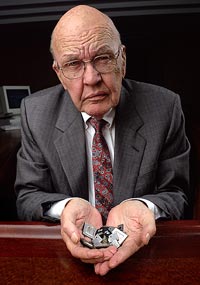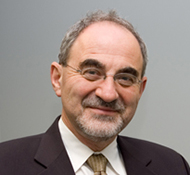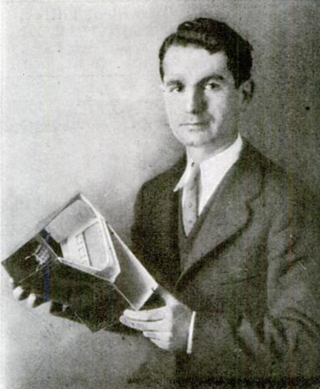
Jack St. Clair Kilby was an American electrical engineer who took part, along with Robert Noyce of Fairchild Semiconductor, in the realization of the first integrated circuit while working at Texas Instruments (TI) in 1958. He was awarded the Nobel Prize in Physics on 10 December 2000.

Eli Yablonovitch is an American physicist and engineer who, along with Sajeev John, founded the field of photonic crystals in 1987. He and his team were the first to create a 3-dimensional structure that exhibited a full photonic bandgap, which has been named Yablonovite. In addition to pioneering photonic crystals, he was the first to recognize that a strained quantum-well laser has a significantly reduced threshold current compared to its unstrained counterpart. This is now employed in the majority of semiconductor lasers fabricated throughout the world. His seminal paper reporting inhibited spontaneous emission in photonic crystals is among the most highly cited papers in physics and engineering.
Jerome "Jerry" Hal Lemelson was an American engineer, inventor, and patent holder. Several of his inventions telate to warehouses, industrial robots, cordless telephones, fax machines, videocassette recorders, camcorders, and the magnetic tape drive. Lemelson's 605 patents made him one of the most prolific inventors in American history.
In the 19th century, it was observed that the sunlight striking certain materials generates detectable electric current – the photoelectric effect. This discovery laid the foundation for solar cells. Solar cells have gone on to be used in many applications. They have historically been used in situations where electrical power from the grid was unavailable.

Luther George Simjian was an Armenian-American inventor and entrepreneur. A prolific and professional inventor, he held over 200 patents, mostly related to optics and electronics. His most significant inventions were a pioneering flight simulator, arguably the first ATM and improvement to the teleprompter.

Stanford Robert Ovshinsky was an American engineer, scientist and inventor who over a span of fifty years was granted well over 400 patents, mostly in the areas of energy and information. Many of his inventions have had wide-ranging applications. Among the most prominent are: the nickel-metal hydride battery, which has been widely used in laptop computers, digital cameras, cell phones, and electric and hybrid cars; flexible thin-film solar energy laminates and panels; flat panel liquid crystal displays; rewritable CD and DVD discs; hydrogen fuel cells; and nonvolatile phase-change memory.

A solar panel is a device that converts sunlight into electricity by using photovoltaic (PV) cells. PV cells are made of materials that produce excited electrons when exposed to light. The electrons flow through a circuit and produce direct current (DC) electricity, which can be used to power various devices or be stored in batteries. Solar panels are also known as solar cell panels, solar electric panels, or PV modules.
Energy Conversion Devices (ECD) was an American photovoltaics manufacturer of thin-film solar cells made of amorphous silicon used in flexible laminates and in building-integrated photovoltaics. The company was also a manufacturer of rechargeable batteries and other renewable energy related products. ECD was headquartered in Rochester Hills, Michigan.
Shunpei Yamazaki is a Japanese inventor in the field of computer science and solid-state physics. He is a prolific inventor who is listed as a named inventor of more than 11,000 patent families and more than 26,000 distinct patent publications for his inventions. In 2005, he was named as the most prolific inventor in history by USA Today. Kia Silverbrook subsequently passed Yamazaki on February 26, 2008. Yamazaki then passed Silverbrook in 2017.

Martin Andrew Green is an Australian engineer and professor at the University of New South Wales who works on solar energy. He was awarded the 2021 Japan Prize for his achievements in the "Development of High-Efficiency Silicon Photovoltaic Devices". He is editor-in-chief of the academic journal Progress in Photovoltaics.

Fujio Masuoka is a Japanese engineer, who has worked for Toshiba and Tohoku University, and is currently chief technical officer (CTO) of Unisantis Electronics. He is best known as the inventor of flash memory, including the development of both the NOR flash and NAND flash types in the 1980s. He also invented the first gate-all-around (GAA) MOSFET (GAAFET) transistor, an early non-planar 3D transistor, in 1988.
The Lemelson Foundation is an American 501(c)(3) private foundation. It was started in 1993 by Jerome H. Lemelson and his wife Dorothy. The foundation held total net assets of US$444,124,049 at the end of 2020 and US$484,432,021 at the end of 2021.
Memjet is a printing technology and components company. It maintains its corporate office in San Diego, California, and has offices in Dublin, Sydney, Taipei, Singapore and Boise, Idaho. Memjet's president and chief executive officer, Len Lauer, was appointed in January 2010. Before joining Memjet, Lauer served as executive vice president and chief operating officer of Qualcomm.
Peter Vogel is an Australian inventor and technologist known for developing the Fairlight CMI.

John O'Sullivan is an Australian engineer.

Amit Goyal is a SUNY Distinguished Professor and a SUNY Empire Innovation Professor at SUNY-Buffalo. He leads the Laboratory for Heteroepitaxial Growth of Functional Materials & Devices. He is also Director of the New York State Center of Excellence in Plastics Recycling Research & Innovation, an externally funded center with initial funding of $4.5M for three years at SUNY-Buffalo. He is the founding director of the multidisciplinary and transdisciplinary RENEW Institute at SUNY-Buffalo in Buffalo, New York and served as director from 2015-2021. RENEW is an internally funded research institute at SUNY-Buffalo. For his contributions to UB, in 2019, he was awarded the University at Buffalo or SUNY-Buffalo President's Medal, which recognizes “outstanding scholarly or artistic achievements, humanitarian acts, contributions of time or treasure, exemplary leadership or any other major contribution to the development of the University at Buffalo and the quality of life in the UB community.” This is one of the highest recognitions given at the university.

Jerry M. Woodall is a professor of electrical and computer engineering at the University of California, Davis who is widely known for his revolutionary work on LEDs and semiconductors. Over the course of his career, he has published close to 400 scientific articles and his work has directly contributed to the development of major technologies that are used around the world, such as TVs, optical fibers, and mobile phones. Woodall currently holds over 80 U.S. patents for a variety of inventions and has received prestigious awards from IBM, NASA, and the U.S. President for his contributions to science, technology, and humanity.
Gurtej Singh Sandhu, also known as Gurtej Sandhu, is an inventor in the fields of thin-film processes and materials, VLSI and semiconductor device fabrication. He is recognized for being the all-time seventh most prolific inventor as measured by number of U.S. utility patents. Gurtej has 1382 U.S. utility patents as of October 19, 2021. He was Senior Fellow and Director of Advanced Technology Developments at Micron Technology, before becoming Senior Fellow and Vice President of Micron Technology.
Joseph Appelbaum is a professor (emeritus) in the Engineering Faculty at Tel Aviv University, and former holder of the Ludwig Jokel Chair of Electronics in the faculty. He is a life fellow of IEEE “for contributions to solar conversion systems”.










